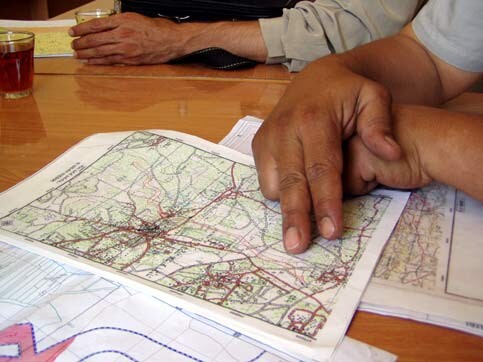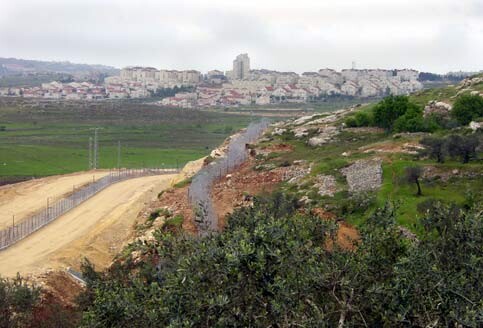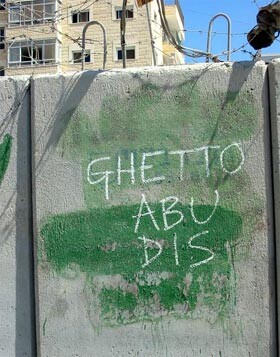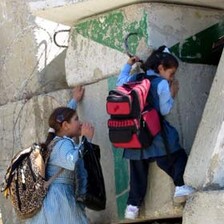The Electronic Intifada 16 November 2003

A demonstration against the Wall in Jayyus. (PENGON/Anti-Apartheid Wall Campaign)
During its spring 2002 offensive to reoccupy territories under Palestinian Authority (PA) control, and as most of the West Bank was under round-the-clock curfew, Israel confiscated thousands of dunums of Palestinian land to build a wall. One year later, a 145-km-long segment of a much longer wall extends from the northern village of Zububa in the Jenin district to ‘Azzun ‘Atma in the Qalqilya district.
When completed, the wall is expected to be at least four times as long and in many places twice as high as the Berlin Wall. But it is no ordinary wall; it is more accurately described as a system of control that includes concrete barriers, watchtowers, trenches on either side, military patrol roads, trace paths to register footprints, an electronic warning or ‘smart’ fence, and a concrete barrier topped with barbed wire.
Israel claims that the wall is a security fence or barrier designed to impede suicide bombers. But the course of the wall as well as its effect on the Palestinians belie that claim. The wall does not follow the Green Line, the demarcation line between Israel and the West Bank. In some areas, it meanders six kilometers east of the Green Line, bisecting some towns, separating villages from their land and water wells, and isolating hamlets from the neighboring towns that provide them medical, educational, and social services.

Palestinian community leaders discuss the route of the Wall. (PENGON/Anti-Apartheid Wall Campaign)
With the completion of this first phase of the wall in the northern West Bank, one can begin to tally the cost to Palestinian economy and society. The Jenin, Tulkarem, and Qalqilya districts have a combined population of more than 500,000 people (22-24 percent of the West Bank population) and accounted for 45 percent of the West Bank’s agricultural production. In these three districts, the wall separates 51 villages from their lands, placing 122,000 dunums beyond reach (in effect, annexing 2% of the West Bank); resulted in the destruction or uprooting of 102,320 trees, dozens of commercial businesses, and 19 miles of water networks; and places 16 villages and 36 groundwater wells in the no-mans-land between the wall and Israel proper. An estimated 200,000 Palestinians are trapped between the wall and Israel proper; in some of these areas, like Jbara, Palestinians are required to secure permits, renewable once a month, to live in their own homes.
In the Jerusalem area, the wall results in the de facto annexation of 800 dunums of land and isolates 30,000 Palestinians in Kafr Aqab and Qalandiya who hold Jerusalem ID cards from the city as well as from family and social and public services. In both the Jerusalem and Bethlehem districts, the Wall surrounds the Palestinian population concentrations rather than the city. The effect of the wall on Bethlehem, whose tourism and export industry has already been shattered by closures and curfews, is especially revealing. According to Hanna Rishmawi, the local coordinator of the Medical Relief Committee, when the wall is completed, the population density of Bethlehem is likely to be about 4,500 people per square kilometer, which puts it in the same league as Gaza, recognized as having the highest population density in the world. The wall will prevent the city from growing naturally and put an end to green spaces in towns.

An Israeli settlement visible in the background, the path shorn through the West Bank for the Wall has resulted in the demolition of hundreds of Palestinian homes and the separation of Palestinians from their agricultural land and only means of livelihood. (PENGON/Anti-Apartheid Wall Campaign)
The implications of the wall are staggering. The wall strips farmers of their farms, thereby depriving them of a livelihood. By so doing, it will impoverish entire communities. Environmental hazards caused by the process of creating the wall as well as psychological pressures deliberately inflicted by the Israeli army (e.g., blaring noise at residents in the early morning hours to prevent sleep; diverting sewage to villages in valleys; dynamiting land to clear it for roads and in the process causing structural damage to nearby homes) are additional pressures on already stressed communities. Lack of water will make Palestinians dependent on Israel for its water supply, for which they will have to pay more than they can afford when they are allowed to have it. Lack of land also means that towns and villages cannot experience normal growth and expansion. Communities that are beyond the wall but not within Israel proper will be unable to sustain themselves.

Grafitti in Abu Dis. (Jos Koster)
The interviews that follow provide a sample of the range of problems that the wall poses for families. The interviews were conducted during August 14-28, 2003, in the districts affected by the completion first phase of the wall: Zububa and al-Taybeh in the Jenin district; Nazlat Isa, al-Jarooshiyeh, and Irtah in the Tulkarem district; al-Daba`a and `Azzun in the Qalqilya district; Qalandiya in the Jerusalem district; and Bethlehem and Beit Jala in the Bethlehem district. The interviews were facilitated by regional coordinators of groups on the Committee Against the Wall. Restrictions placed on traveling between towns and villages made it difficult for me to visit more than a few communities, and so I tried to select towns and villages on which the wall placed varying types of pressures.
Taken together, the interviews reveal what various interviewees independently referred to as the unique tragedies facing communities and the daily tragedies facing individuals, created by the wall.
Interviews
Ida Audeh is a Palestinian from the West Bank who works as a technical writer in Boulder, CO. She went to the West Bank in August for three weeks to visit family and to learn more about the effect of the wall on the lives of ordinary people. She is the author of “Picking Olives and Removing Roadblocks as Acts of Resistance: An Interview with Ghassan Andoni” Counterpunch, 28 October 2002 and “Narratives of Siege: Eyewitness Testimonies from Jenin, Bethlehem, and Nablus,” Journal of Palestine Studies, no. 124 (Summer 2002).





